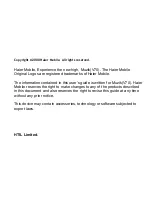
Title: RF Test Report for 3G MOBILE PHONE
Main Model: AC4E
Serial Model: ANDY AC4E, AC4EW
To: FCC Part 15.247: 2013, ANSI C63.4: 2009
Report No.: 13070549-FCC-R3
Issue Date: December 06, 2013
Page: 56 of 74
www.siemic.com.cn
Test Method
The following procedure was performed to determine the maximum emission axis of EUT:
1. With the receiving antenna is H polarization, rotate the EUT in turns with three orthogonal axes to determine the axis
of maximum emission.
2. With the receiving antenna is V polarization, rotate the EUT in turns with three orthogonal axes to determine the axis
of maximum emission.
3. Compare the results derived from above two steps. So, the axis of maximum emission from EUT was determined
and the configuration was used to perform the final measurement.
Final Radiated Emission Measurement
1. Setup the configuration according to figure 1. Turn on EUT and make sure that it is in normal function.
2. For emission frequencies measured below 1 GHz, a pre-scan is performed in a shielded chamber to determine the
accurate frequencies of higher emissions will be checked on a open test site. As the same purpose, for emission
frequencies measured above 1 GHz, a pre-scan also be performed with a 1 meter measuring distance before final test.
3. For emission frequencies measured below and above 1 GHz, set the spectrum analyzer on a 100 kHz and 1 MHz
resolution bandwidth respectively for each frequency measured in step 2.
4. The search antenna is to be raised and lowered over a range from 1 to 4 meters in horizontally polarized orientation.
Position the highness when the highest value is indicated on spectrum analyzer, then change the orientation of EUT on
test table over a range from 0
。
to 360
。
with a speed as slow as possible, and keep the azimuth that highest emission is
indicated on the spectrum analyzer. Vary the antenna position again and record the highest value as a final reading.
5. Repeat step 4 until all frequencies need to be measured was complete.
6. Repeat step 5 with search antenna in vertical polarized orientations.
During the radiated emission test, the Spectrum Analyzer was set with the following configurations:
Frequency Band (MHz)
Function
Resolution bandwidth
Video Bandwidth
30 to 1000
Peak
100 kHz
100 kHz
Above 1000
Peak
1 MHz
1 MHz
Average
1 MHz
10 Hz
Sample Calculation Example
The field strength is calculated by adding the Antenna Factor and Cable Factor, and subtracting the Amplifier Gain (if
any) from the measured reading. For the limit is employed average value, therefore the peak value can be transferred to
average value by subtracting the duty factor. The basic equation with a sample calculation is as follows:
Peak = R Corrected Factor
where
Corr. Factor = Antenna Cable Factor - Amplifier Gain (if any)
And the average value is
Average = Peak Value + Duty Factor or
Set RBW = 1MHz, VBW = 10Hz.
Note :
If the measured frequencies are fall in the restricted frequency band, the limit employed must be quasi peak value when
frequencies are below or equal to 1 GHz. And the measuring instrument is set to quasi peak detector function.
















































